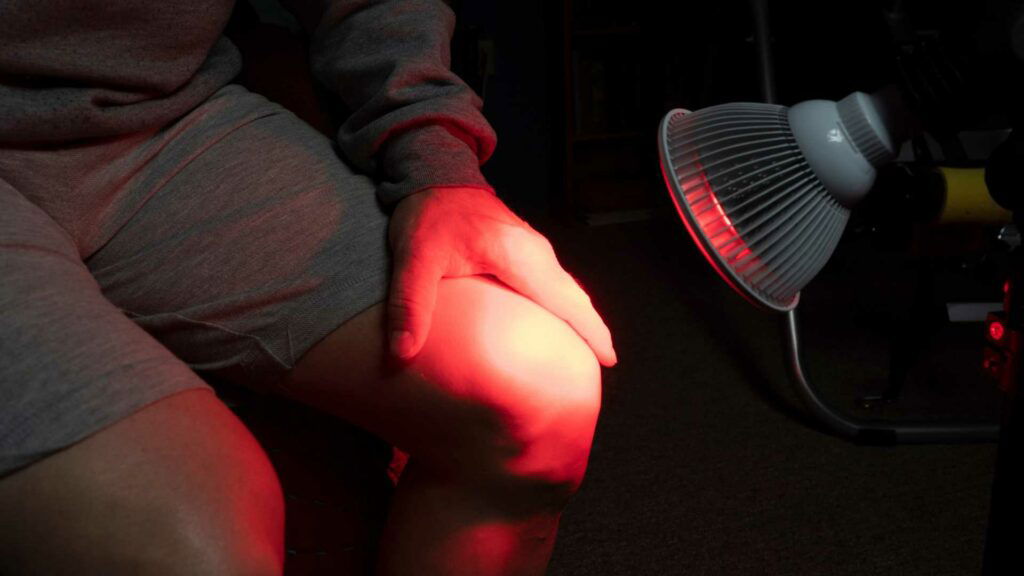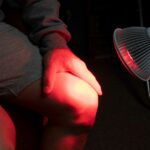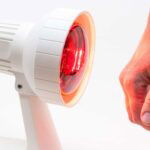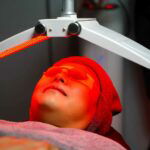Red Light Therapy for Muscle Recovery: A non-invasive treatment using specific wavelengths to penetrate muscles, enhancing cellular metabolism, reducing inflammation, and accelerating tissue repair. Ideal for athletes seeking faster recovery and improved performance.
Unveiling the Power of Red Light Therapy in Muscle Recovery
Redefining Recovery: A New Dawn in Athletic Performance
Muscle recovery isn’t just a phase; it’s the secret sauce in the recipe for athletic excellence. Traditional methods have had their day, but now a new player enters the arena – red light therapy. This non-invasive marvel isn’t just another trend; it’s a game-changer in speeding up recovery and reducing downtime. Today, let’s journey into the heart of red light therapy, understand its scientific prowess in muscle healing, and uncover its treasure trove of benefits for athletes and fitness buffs. Plus, get ready for some practical tips on how to weave this therapy into your recovery routine.
The Science of Healing: A Light that Leads the Way
Imagine a light—not just any light, but one that dives deep into your muscles, whispering to the cells to wake up and rejuvenate. That’s red light therapy for you. It uses specific light wavelengths, dancing in the red to near-infrared spectrum, penetrating your skin like a gentle warrior. It’s in the muscle tissue that the magic happens – the mitochondria, those cellular powerhouses, absorb this light, kickstarting a domino effect of energy production.
This isn’t just light; it’s a cellular energizer. Red light therapy amplifies ATP synthesis, sparking cellular metabolism, fostering protein synthesis, and improving circulation. Think of it as a muscle whisperer, easing inflammation, speeding up tissue repair, and soothing soreness. It’s not just healing; it’s about empowering cells, nudging key signaling pathways, and fostering the growth of muscle fibers anew.
Red Light Therapy: A Champion for Athletes and Fitness Enthusiasts
- Speedy Recovery: Picture cutting down recovery times dramatically. That’s red light therapy for you. It’s like having a personal healer, reducing inflammation and encouraging cellular repair, so you’re ready faster for your next workout or bouncing back from an injury.
- Soreness, Be Gone: Muscle soreness can be a real party pooper, but red light therapy steps in like a soothing balm. It’s about bouncing back with more vigor, ready to take on greater challenges without the ghost of soreness holding you back.
- Elevated Performance: Imagine boosting your athletic prowess just by recovering better. Red light therapy is your secret weapon, enhancing muscle repair, slashing recovery time, and upping your game in strength, endurance, and overall athletic prowess.
- Guarding Against Injuries: It’s not just about healing; it’s about prevention. Red light therapy keeps muscle tissues in prime condition, lowering the risk of injury. And if injuries do knock on your door, this therapy is there to speed up healing and minimize scar tissue, helping you stay in the game.
Let’s embrace this light, not just as a remedy but as a partner in our journey towards athletic brilliance and vibrant health. Red light therapy isn’t just therapy; it’s a revolution in the way we heal, recover, and excel.
Transforming Muscle Recovery: Real Stories, Real Results with Red Light Therapy
Witnessing the Change: Athletes’ Journey with Red Light Therapy
Imagine a world where recovery is not just quick but profound. That’s the reality for many athletes and fitness enthusiasts who’ve embraced red light therapy. From sprinters to weightlifters, cyclists to gym warriors, the tales are rolling in. They’re talking about slashed recovery times, amped-up performance, and muscles that just feel better. These aren’t just stories; they’re testaments to the transformative power of red light therapy, painting a picture of a future where muscle recovery is redefined.
- Emily’s Sprint to Recovery: Emily, a track and field athlete, shares, “After incorporating red light therapy into my routine, I’ve noticed a significant reduction in recovery time. My muscles feel more rejuvenated, allowing me to train harder and more frequently.”
- Mark’s Weightlifting Win: Mark, a competitive weightlifter, recounts, “I was skeptical at first, but red light therapy has been a game-changer. My post-training soreness has dramatically decreased, and I feel stronger during my sessions.”
- Cycling with Zoe: Zoe, an avid cyclist, reveals, “Long rides used to leave me with considerable muscle fatigue. Since using red light therapy, my recovery is faster, and my performance has improved noticeably.”
These stories aren’t just anecdotes; they are echoes of a new reality in muscle recovery, painting a vivid picture of the future that red light therapy is creating.
Crafting Your Muscle Recovery Saga with Red Light Therapy
- Choosing Your Light Saber: It all starts with picking the right red light therapy device. You’re looking for one tailored for muscle recovery, emitting those sweet-spot wavelengths (think 630-850 nm) and packing enough power to dive deep into your muscle tissue.
- Timing It Right: Begin with bite-sized sessions, about 5-10 minutes, and let your body lead the way as you gradually extend these times. Aim for a rhythm of 2-3 sessions a week, giving your body the space to adapt and respond to this luminous therapy.
- Spot-On Application: The key is in the positioning. Make sure your red light therapy device is cozily distanced from your target muscles, following the golden rules set by the manufacturer for distance and duration, to reap the best therapeutic rewards.
- The Holistic Dance: Remember, red light therapy loves company. Pair it with the classics – balanced nutrition, hydration, foam rolling, stretching, and ample rest. It’s about creating a symphony of recovery practices, with red light therapy playing a leading role.
Navigating with Care: The Safe Way to Red Light Therapy
While red light therapy is a beacon of safety, a few signposts should guide your journey:
- Shield Your Eyes: These devices are bright, so eye protection is a must. Don some goggles or eye shields to keep your peepers safe from the light’s intensity.
- Skin First: If you’re someone with a tender skin story or a history of skin quirks, tread lightly. Start with shorter light sessions and watch how your skin reacts. Any signs of rebellion (like redness or irritation), and it’s time to pause and perhaps chat with a health expert.
- Health Conditions and Medications: In the land of red light therapy, your health history and medications are important characters. Have a sit-down with your healthcare professional to ensure this light journey harmonizes with your personal health narrative.
Red light therapy isn’t just another tool; it’s a revolution in muscle recovery. As you embark on this journey, remember, it’s about more than healing; it’s about transforming how you recover, perform, and thrive.
Exploring Tomorrow: The Bright Future of Red Light Therapy
Unfolding the Research: The Quest to Harness Red Light Therapy’s Full Potential
Dive into the world of red light therapy, where the story is still being written. The existing research paints a picture of promise, but the canvas is vast, and the brushstrokes of ongoing studies are adding depth and detail. Scientists are like detectives, uncovering clues about the optimal wavelengths, dosages, and protocols that make red light therapy tick. They’re not just looking at the surface; they’re delving into the cellular narrative, piecing together how this therapy weaves its magic on muscle recovery.
As this tapestry of knowledge expands, expect red light therapy to step into the limelight of mainstream recovery practices. It’s not just a therapy; it’s poised to be a revolution, redefining how athletes and fitness enthusiasts recover, perform, and achieve their zenith.
Conclusion: Stepping Into a New Era of Muscle Recovery with Red Light Therapy
Red light therapy isn’t just a treatment; it’s a beacon of innovation in the world of muscle recovery. It’s a symphony of specific light wavelengths that speaks the language of healing, reducing inflammation, and sculpting muscles into their best form.
Integrating red light therapy into your recovery narrative could be your secret weapon. It’s about recovery that’s not just faster, but deeper; not just relieving soreness, but transforming your performance. Select your device wisely, dance to the rhythm of recommended session timings and frequencies, and let red light therapy be part of a broader recovery chorus.
So, are you ready to turn the page and step into this new chapter of muscle recovery? The journey begins with a simple step. Discover a red light therapy provider near you by visiting FindRedLightNearMe.com. Embrace this luminous path and unlock a new realm of athletic performance and muscle well-being.
Welcome to the era of red light therapy – where recovery is reimagined and your peak performance is just a wavelength away.
FAQs:
How soon can I expect to see results from red light therapy for muscle recovery?
Results may vary depending on individual factors, the severity of muscle damage, and consistency with therapy sessions. Some individuals report noticeable improvements in muscle recovery within a few weeks, while for others, it may take more time. Consistency and adherence to recommended usage guidelines are key for optimal results.
Can I use red light therapy in combination with other muscle recovery techniques, such as ice baths or compression therapy?
Yes, red light therapy can be combined with other muscle recovery techniques. However, it’s essential to consult with a healthcare professional or sports therapist to ensure compatibility and avoid any potential adverse effects.
Is red light therapy safe for all athletes and fitness enthusiasts?
Red light therapy is generally considered safe for most individuals. However, it’s always recommended to consult with a healthcare professional or sports therapist before incorporating any new therapy into your routine, especially if you have any underlying medical conditions or are undergoing specific treatments.







